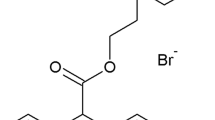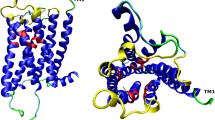Abstract.
The potential interaction of acetylcholinesterase inhibitors with cholinergic receptors may play a significant role in the therapeutic and/or side-effects associated with this class of compound. In the present study, the capacity of acetylcholinesterase inhibitors to interact with muscarinic receptors was assessed by their ability to displace both [3H]-oxotremorine-M and [3H]-quinuclinidyl benzilate binding in rat brain membranes. The [3H]-quinuclinidyl benzilate/[3H]-oxotremorine-M affinity ratios permitted predictions to be made of either the antagonist or agonist properties of the different compounds. A series of compounds, representative of the principal classes of acetylcholinesterase inhibitors, displaced [3H]-oxotremorine-M binding with high-to-moderate potency (ambenonium>neostigmine=pyridostigmine=tacrine>physostigmine>edrophonium=galanthamine>desoxypeganine) whereas only ambenonium and tacrine displaced [3H]-quinuclinidyl benzilate binding. Inhibitors such as desoxypeganine, parathion and gramine demonstrated negligible inhibition of the binding of both radioligands. Scatchard plots constructed from the inhibition of [3H]-oxotremorine-M binding in the absence and presence of different inhibitors showed an unaltered B max and a reduced affinity constant, indicative of potential competitive or allosteric mechanisms. The capacity of acetylcholinesterase inhibitors, with the exception of tacrine and ambenonium, to displace bound [3H]-oxotremorine-M in preference to [3H]-quinuclinidyl benzilate predicts that the former compounds could act as potential agonists at muscarinic receptors. Moreover, the rank order for potency in inhibiting acetylcholinesterase (ambenonium>neostigmine=physostigmine=tacrine>pyridostigmine=edrophonium=galanthamine>desoxypeganine>parathion>gramine) indicated that the most effective inhibitors of acetylcholinesterase also displaced [3H]-oxotremorine-M to the greatest extent. The capacity of these inhibitors to displace [3H]-oxotremorine-M binding preclude their utilisation for the prevention of acetylcholine catabolism in rat brain membranes, the latter being required to estimate the binding of acetylcholine to [3H]-oxotremorine-M-labelled muscarinic receptors. However, fasciculin-2, a potent peptide inhibitor of acetylcholinesterase (IC50 24 nM), did prevent catabolism of acetylcholine in rat brain membranes with an atypical inhibition isotherm of [3H]-oxotremorine-M binding, thus permitting an estimation of the "global affinity" of acetylcholine (K i 85 nM) for [3H]-oxotremorine-M-labelled muscarinic receptors in rat brain.
Similar content being viewed by others
Author information
Authors and Affiliations
Additional information
Electronic Publication
Rights and permissions
About this article
Cite this article
, ., , ., , . et al. Differential inhibition of [3H]-oxotremorine-M and [3H]-quinuclinidyl benzilate binding to muscarinic receptors in rat brain membranes with acetylcholinesterase inhibitors. Naunyn-Schmied Arch Pharmacol 363, 429–438 (2001). https://doi.org/10.1007/s002100000382
Received:
Accepted:
Issue Date:
DOI: https://doi.org/10.1007/s002100000382




